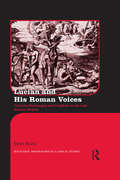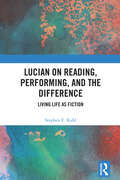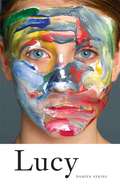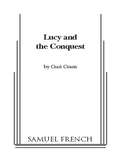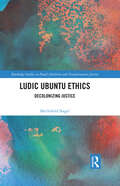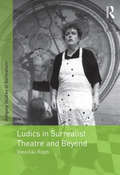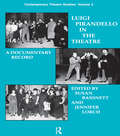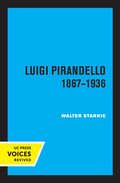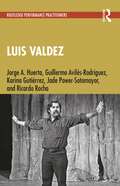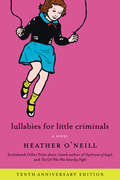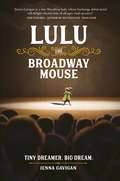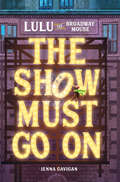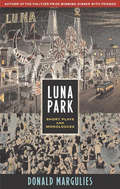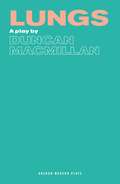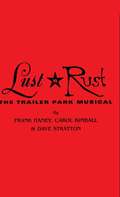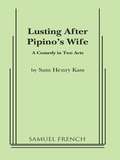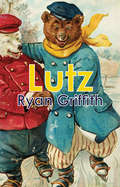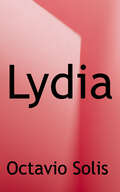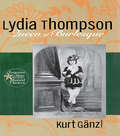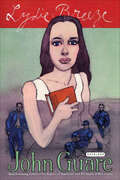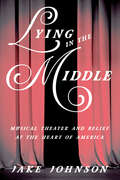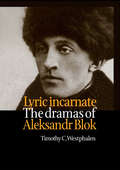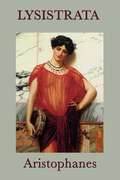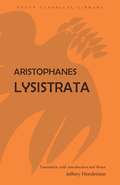- Table View
- List View
Lucian and His Roman Voices: Cultural Exchanges and Conflicts in the Late Roman Empire (Routledge Monographs in Classical Studies #19)
by Eleni BoziaLucian and His Roman Voices examines cultural exchanges, political propaganda, and religious conflicts in the Early Roman Empire through the eyes of Lucian, his contemporary Roman authors, and Christian Apologists. Offering a multi-faceted analysis of the Lucianic corpus, this book explores how Lucian, a Syrian who wrote in Greek and who became a Roman citizen, was affected by the socio-political climate of his time, reacted to it, and how he ‘corresponded’ with the Roman intelligentsia. In the process, this unique volume raises questions such as: What did the title ‘Roman citizen’ mean to native Romans and to others? How were language and literature politicized, and how did they become a means of social propaganda? This study reveals Lucian’s recondite historical and authorial personas and the ways in which his literary activity portrayed second-century reality from the perspectives of the Romans, Greeks, pagans, Christians, and citizens of the Roman Empire
Lucian on Reading, Performing, and the Difference: Living Life as Fiction
by Stephen E. KiddLucian’s writings raise questions about the nature of reading and viewing the lives of others; this book explores these questions through close readings of Lucian’s dialogues and stories.Lucian scholarship over the past decades has been dominated by terms like performance and personas, so this book asks simply: what happens when we are not performing? When we read or sit in the audience, we cannot perform for the world we are viewing. Nor can we act on our desires and beliefs, since we have no self in that viewed world to move around like an avatar. Is there anything left of us at such moments? As a satirist, Lucian explored these questions not through philosophical arguments but stories – a traveler who looks down on earth from the moon, a philosopher who retires to a contemplative life “as if high up in a theater”, a narrator who demands that a reader not believe anything he writes, and many more. Over the course of seven chapters, this book explores these questions of reading, performing, and the difference via detailed analyses of some of Lucian’s best-known works: Hermotimus, Charon, Icaromenippus, Nigrinus, Rooster, True Stories, and others.Lucian on Reading, Performing, and the Difference is suitable for students and scholars of ancient Greek literature, Classics and the Humanities, particularly those interested in questions about Lucian and literary interpretation.
Lucy
by Damien AtkinsReluctantly, Vivian agrees, although motherhood is something that she never desired. Overwhelmed by the particulars of Lucy's care and unable to connect with her daughter at first, Vivian soon realizes that Lucy isn't that different from her—socially awkward, emotionally withholding, and reclusive—and slowly comes to believe that she and Lucy are the next step in the evolutionary chain. A powerful play about the relationship between mother and daughter, the power of love, and the rare moments in life when something, or someone, comes along and forces us to re-evaluate our own lives and the way we respond to the world around us.
Lucy And The Conquest
by Cusi Cram5m, 3f, doubling possible / Dramatic Comedy / Pill popping Lucy Santiago heads to her family home in Bolivia after being fired from the syndicated hit "Beach Detectives". All she wants to do is forget her troubles but her wildly eccentric family and a mysterious spirit that lives under Simon Bolivar's campaign bed won't let her. Lucy is forced to confront her own troubled history as well as the history of a conquered people. / "Lucy and the Conquest is a wild ride." - Jeffrey Borak, Berkshire Eagle
Ludic Ubuntu Ethics: Decolonizing Justice (Routledge Studies in Penal Abolition and Transformative Justice)
by Mechthild NagelLudic Ubuntu Ethics develops a positive peace vision, taking a bold look at African and Indigenous justice practices and proposes new relational justice models. ‘Ubuntu’ signifies shared humanity, presenting us a sociocentric perspective of life that is immensely helpful in rethinking the relation of offender and victim. In this book, Nagel introduces a new theoretical liberation model—ludic Ubuntu ethics—to showcase five different justice conceptions through a psychosocial lens, allowing for a contrasting analysis of negative Ubuntu (eg., through shaming and separation) towards positive Ubuntu (eg., mediation, healing circles, and practices that no longer rely on punishment). Providing a novel perspective on penal abolitionism, the volume draws on precolonial (pre-carceral) Indigenous justice perspectives and Black feminism, using discourse analysis and a constructivist approach to justice theory. Nagel also introduces readers to a post secular turn by taking seriously the spiritual dimensions of healing from harm and highlighting the community’s response. Spanning disciplinary boundaries and aimed at readers seeking to understand how to move beyond reintegrative shaming and restorative justice theories, the volume will engage scholars of criminology, philosophy and law, and more specifically penal abolitionism, social ethics, peace studies, African studies, critical legal studies, and human rights. It will also be of great interest to practitioners and activists in restorative justice, mediation, social work, and performance studies.
Ludics in Surrealist Theatre and Beyond (Studies in Surrealism)
by Vassiliki RaptiTaking as its point of departure the complex question about whether Surrealist theatre exists, this book re-examines the much misunderstood artistic medium of theatre within Surrealism, especially when compared to poetry and painting. This study reconsiders Surrealist theatre specifically from the perspective of ludics-a poetics of play and games-an ideal approach to the Surrealists, whose games blur the boundaries between the 'playful' and the 'serious.' Vassiliki Rapti's aims are threefold: first, to demystify André Breton's controversial attitude toward theatre; second, to do justice to Surrealist theatre, by highlighting the unique character that derives from its inherent element of play; and finally, to trace the impact of Surrealist theatre in areas far beyond its generally acknowledged influence on the Theatre of the Absurd-an impact being felt even on the contemporary world stage. Beginning with the Surrealists' 'one-into-another' game and its illustration of Breton's ludic dramatic theory, Rapti then examines the traces of this kind of game in the works of a wide variety of Surrealist and Post-Surrealist playwrights and stage directors, from several different countries, and from the 1920s to the present: Roger Vitrac, Antonin Artaud, Günter Berghaus, Nanos Valaoritis, Robert Wilson, and Megan Terry.
Luigi Pirandello in the Theatre
by Susan Bassnett Jennifer LorchFirst Published in 1993. Routledge is an imprint of Taylor & Francis, an informa company.
Luigi Pirandello, 1867 - 1936, 3rd Edition
by Walter StarkieThis title is part of UC Press's Voices Revived program, which commemorates University of California Press’s mission to seek out and cultivate the brightest minds and give them voice, reach, and impact. Drawing on a backlist dating to 1893, Voices Revived makes high-quality, peer-reviewed scholarship accessible once again using print-on-demand technology. This title was originally published in 1965.
Luis Valdez (Routledge Performance Practitioners)
by Ricardo Rocha Jorge A. Huerta Guillermo Avilés-Rodríguez Karina Gutiérrez Jade Power-SotomayorLuis Valdez studies the life and work of this Chicano playwright, director, performer, and producer along with the implications of his legacy for Chicana/o/x communities and for all who engage with his work.Valdez’s work broadened the scope of theater and arts in the Chicano community, and his formation of El Teatro Campesino brought together students and farmworkers. This volume highlights his professional work and writings. It offers a unique investigation of Luis Valdez, his life, his oeuvre, and his contributions to the theater in the United States and beyond. This book combines: an in-depth biographical overview of Valdez’s life and career, focusing on defining experiences that set his trajectory into motion; an exploration of Valdez’s key writings—the 1973 epic poem Pensamiento Serpentino and the unpublished lecture The Power of Zero which articulate his philosophy of the Theatre of the Sphere; a stylistic analysis of his key works, including Soldado Razo and Zoot Suit as well as their critical reception; and a selection of improvisation and dance-based warm-ups, embodiment exercises, and an acto writing practicum adapted to experiment with Valdez’s works. As a first step towards critical understanding, and as an initial exploration before going on to further, primary research, Routledge Performance Practitioners offer unbeatable value for today’s students.
Lullabies for Little Criminals: A Novel
by Heather O'Neill“A beautiful book. . . . There are phrases in here that will make you laugh out loud, and others that will stop your heart. A definite triumph.” — David Rakoff, author of Love, Dishonor, Marry, Die, Cherish, PerishFrom Heather O'Neill, the Giller-shortlisted author of Daydreams of Angels and The Girl Who Was Saturday Night, a heartbreaking and wholly original novel about a young girl fighting to preserve a bruised innocence on the feral streets of a big cityBaby, all of thirteen years old, is lost in the gangly, coltish moment between childhood and the strange pulls and temptations of the adult world. Her mother is dead; her father Jules is always on the lookout for his next score. Baby knows that “chocolate milk” is Jules’ slang for heroin and sees a lot more of that in her house than the real article. But she takes vivid delight in the scrappy bits of happiness and beauty that find their way to her, and moves through the threat of the streets as if she’s been choreographed in a dance.Soon, though, a hazard emerges that is bigger than even her hard-won survival skills can handle. Alphonse, the local pimp, has his eye on her for his new girl; he wants her body and soul—and what the johns don’t take he covets for himself. At the same time, a tender and naively passionate friendship unfolds with a boy from her class at school, who has no notion of the dark claims on her—which even her father, lost on the nod, cannot totally ignore. Jules consigns her to a stint in juvie hall, and for the moment this perceived betrayal preserves Baby from terrible harm—but after that, her salvation has to be her own invention.Channeling the artlessly affecting voice of her thirteen-year-old heroine with extraordinary accuracy and power, O’Neill’s dazzles with a novel of extraordinary prescience and power, a subtly understated yet searingly effective story of a young life on the streets—and the strength, wits, and luck necessary for survival.
Lulu the Broadway Mouse (The Broadway Mouse Series)
by Jenna GaviganRatatouille meets Broadway in this charming new middle grade novel about a little mouse with big dreams. Lulu is a little girl with a very big dream: she wants to be on Broadway. She wants it more than anything in the world. As it happens, she lives in Broadway's Shubert Theatre; so achieving her dream shouldn't be too tricky, right? Wrong. Because the thing about Lulu? She's a little girl mouse.When a human girl named Jayne joins the cast of the show at the Shubert as an understudy, Lulu becomes Jayne's guide through the world of her theatre and its wonderfully kooky cast and crew. Together, Jayne and Lulu learn that sometimes dreams turn out differently than we imagined; sometimes they come with terms and conditions (aka the company mean girl, Amanda). But sometimes, just when we've given up all hope, bigger and better dreams than we'd ever thought could come true, do.
Lulu the Broadway Mouse: The Show Must Go On (The Broadway Mouse series)
by Jenna GaviganLulu's show has just received its closing notice. Lulu and the rest of the company are devastated. Lulu takes readers back in time to just after she made her onstage debut and of Lulu and Jayne rising in popularity and esteem. However, there is one critic who is determined to break Lulu's career. With additional casting drama happening with Jayne, Amanda, and new girl Olivia, the news about the show closing comes as a real blow to everyone. When Benji, Lulu's brother, comes up with an idea on how to boost ticket sales, the company members hit the streets, desperate to save the show from closing. But will Lulu and Stella be able to stop the nasty critic from completely ruining Lulu's dreams and those of the rest of the cast?
Luna Park
by Donald MarguliesDrawing from his own, specific experience, Margulies has indeed created what he calls "a window to the world" at large. The bits and pieces and detritus of our culture have been used to construct a powerful drama about a new and devastating age of anxiety in the United States. July 7, 1994 ranks as an important work by a gifted and growing American playwright."--Chicago Tribune This new anthology by Donald Margulies collects his best short plays and monologues written over the past 24 years. Taken as a whole, the work is an extraordinary representation of a particularly American reality of the twentieth century. His language is exquisite and deceptive in its simplicity, wherein the larger questions of our daily existence emerge and are clarified. The volume contains three major one-act plays including July 7, 1994, the hit of the 1995 Humana Festival at the Actors Theatre of Louisville; Pitching to the Stars, a darkly comic look at the writers lot in Hollywood; and Luna Park, an elegiac look at the American past and the immigrant experience, based on a short story by Delmore Schwartz. The volume also includes fifteen other short plays and monologues.Donald Margulies is the author of numerous plays, including Dinner with Friends and Collected Stories, both being filmed for television by HBO and PBS. Mr. Margulies lives with his wife and son in New Haven, Connecticut, where he teaches playwriting at Yale University. Also available by Donald Margulies Dinner with FriendsPB $11.95 1-55936-194-8 * USA Collected StoriesPB $11.95 1-55936-152-2 * USA Sight Unseen and Other PlaysPB $16.95 1-55936-103-4 * USA
Lungs: Modern Plays
by Duncan Macmillan'I could fly to New York and back every day for seven years and still not leave a carbon footprint as big as if I have a child. Ten thousand tonnes of CO2. That's the weight of the Eiffel Tower. I'd be giving birth to the Eiffel Tower.' <P><P> In a time of global anxiety, terrorism, erratic weather and political unrest, a young couple want a child but are running out of time. If they over think it, they'll never do it. But if they rush, it could be a disaster. They want to have a child for the right reasons. Except, what exactly are the right reasons? And what will be the first to destruct – the planet or the relationship?
Lust 'N' Rust: The Trailer Park Musical
by Frank HaneyNewly Revised! The intriguing loves and heartaches of residents at the Red Bud Mobile Estates in Twister Plaines, Illinois are revealed in an appealing story with quirky characters and fourteen original alternative country songs. Can the new manager of the AgriBig Plant find love with the soon to be divorced waitress at Smittie's Diner? Falling for the waitress who serves your patty melt... Telling your boss to go to hell... Living paycheck to paycheck, while you still can... It's Lust 'n' Rust: The Trailer Park Musical!
Lusting After Pipino's Wife
by Sam Henry KassThis cleverly constructed comedy about the never ending war between the sexes centers around a restaurant owner and his best friend. Vinnie and Patsy like to sit around talking about women and about life in general. A favorite topic is the restaurant dishwasher's gorgeous wife. Vinnie can't understand how a nobody like Pipino can have such a wife. In fact, he doesn't understand why women won't give him the time of day, especially tough as nails Lorraine whose friend Rita dates Patsy. Patsy decides he can find success selling shoes on the street and he proposes to Rita. Their wedding is disrupted by a gun welding Lorraine who rescues Rita from the altar, leaving Vinnie and Patsy to speculate and commiserate again about the mysteries of women. Note: This play contains some wonderful monologue and scene material, much of which has been anthologized elsewhere.
Lutz
by Ryan GriffithThinking to find peace from his troubles, Christian realizes his brother still resents him for leaving with their mother years ago, and he struggles to fight those haunting memories. But the past has ways of coming back, and soon Christian finds himself struggling to separate memory from reality. As two interlaced stories become one, the courtship and marriage of Joe and Marty Miller and the reunion of their two sons, the haunting reality of childhood and loss strikes with a vengeance.
Lycurgan Athens and the Making of Classical Tragedy
by Johanna HaninkThrough a series of interdisciplinary studies this book argues that the Athenians themselves invented the notion of 'classical' tragedy just a few generations after the city's defeat in the Peloponnesian War. In the third quarter of the fourth century BC, and specifically during the 'Lycurgan Era' (338-322 BC), a number of measures were taken in Athens to affirm to the Greek world that the achievement of tragedy was owed to the unique character of the city. By means of rhetoric, architecture, inscriptions, statues, archives and even legislation, the 'classical' tragedians (Aeschylus, Sophocles and Euripides) and their plays came to be presented as both the products and vital embodiments of an idealised Athenian past. This study marks the first account of Athens' invention of its own theatrical heritage and sheds new light upon the interaction between the city's literary and political history.
Lydia
by Octavio SolisDrama / 4m, 3f Set in the 1970s on the Texas border separating the United States and Mexico, Lydia is an intense, lyrical, and magical new play. The Flores family welcomes Lydia, an undocumented maid, into their El Paso home to care for their daughter Ceci, who was tragically disabled in a car accident on the eve of her quincea era, her fifteenth birthday. Lydia's immediate and seemingly miraculous bond with the girl sets the entire family on a mysterious and shocking journey of discovery.
Lydia Thompson: Queen of Burlesque (Forgotten Stars of the Musical Theatre)
by Kurt GanzlFirst Published in 2002. Routledge is an imprint of Taylor & Francis, an informa company.
Lydie Breeze
by John Guare“Two previously produced full-length plays . . . welded into a seamless whole . . . is wonderful theater and satisfying, compelling reading.” —BooklistFrom award winning playwright John Guare, an extensive reworking of his two 1981 plays about a nineteenth-century commune in Nantucket. Lydie Breeze is a two-play, six-hour cycle about four seekers who come to the island to create a special model for a better world in the ashes of the Civil War and end up as a model for the corruption of twentieth-century idealism. The result is an almost surreal saga of American life, with allegorical meditations on the contradictions and interconnectedness of all things and the chaotic nature of the universe.
Lying in the Middle: Musical Theater and Belief at the Heart of America (Music in American Life)
by Jake JohnsonThe local and regional shows staged throughout America use musical theater’s inherent power of deception to cultivate worldviews opposed to mainstream ideas. Jake Johnson reveals how musical theater between the coasts inhabits the middle spaces between professional and amateur, urban and rural, fact and fiction, fantasy and reality, and truth and falsehood. The homegrown musical provides a space to engage belief and religion—imagining a better world while creating opportunities to expand what is possible in the current one. Whether it is the Oklahoma Senior Follies or a Mormon splinter group’s production of The Sound of Music, such productions give people a chance to jolt themselves out of today’s post-truth malaise and move toward a world more in line with their desires for justice, reconciliation, and community. Vibrant and strikingly original, Lying in the Middle discovers some of the most potent musical theater taking place in the hoping, beating hearts of Americans.
Lyric Incarnate: The dramas of Aleksandr Blok
by Timothy WestphalenLyric Incarnate examines the plays of Aleksandr Blok, the pre-eminent poet of Russian Symbolism and one of the greatest poets of the twentieth century. Blok's plays have received less attention than his poetry in the West, and this book is the first and only English-language monograph devoted to Blok the playwright. In chronological succession, each of Blok's major plays is examined in detail. Special attention is accorded to Blok's relations with the major directors of his time, particularly Meyerhold and Stanislavsky. Blok's role, for instance, in Meyerhold's formulation of the theatre of the grotesque proved to be critical, and his relation to the Moscow Art Theatre just before the October Revolution helped to define the future course of that theatre. Blok's innovative dramatic technique is carefully studied at each stage in his career, from his earliest "lyric dramas" , such as A Puppet Show and The Stranger, to his great tragedy The Rose and the Cross.
Lysistrata
by AristophanesAristophanes' play, Lysistrata, takes place toward the end of the Peloponnesian War and centers on the lives of the soldiers' wives. One woman, Lysistrata, under the impression that a man's libido is ultimately his driving force in life, comes up with an interesting peace solution: to deny their husbands sexual relations until they can settle on a peace agreement that will end the war. However, Lysistrata's strategy effectively creates even more war than before as the sexes begin to feud with each other. Aristophanes' play is both comic and poignant as it reveals the relationship between men and women in classical Athens society.
Lysistrata
by Aristophanes Jeffrey HendersonThis English translation of Aristophanes' most popular comedy will appeal to the modern reader because of its lively and imaginative plot, memorable heroine, good jokes, and appeal for peace and tolerance between nations and between the sexes. This edition includes background material on the historical and cultural context of this work, suggestions for further reading, notes, and a map. The Focus Classical Library provides close translations with notes and essays to provide access to understanding Greek culture and the roots of contemporary thought.
